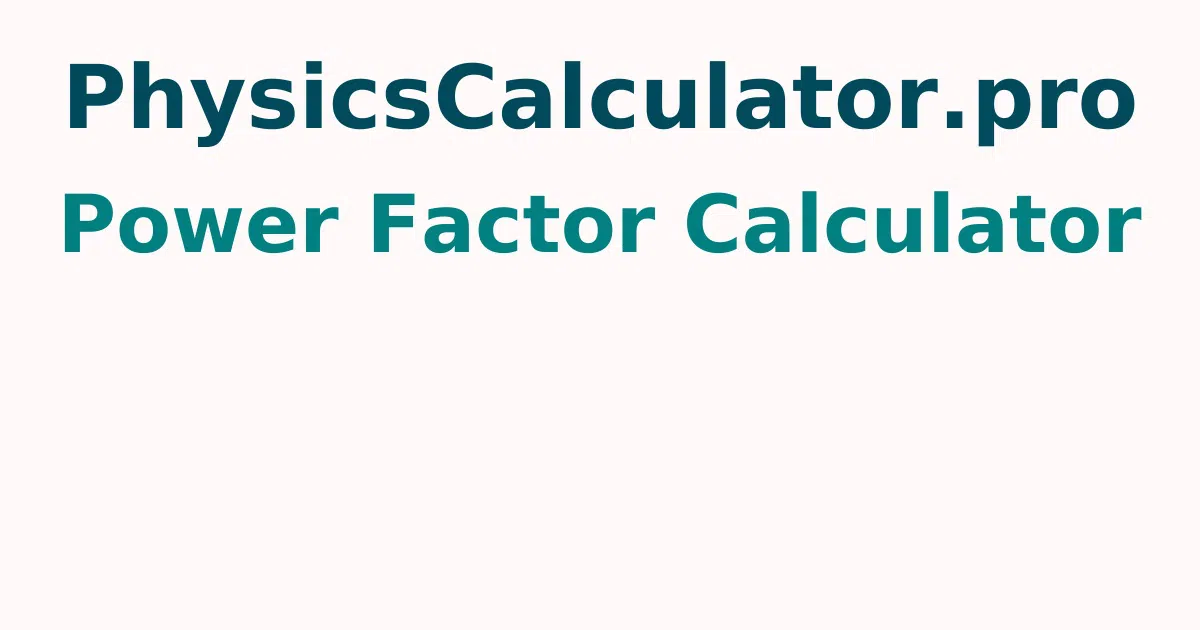Power Factor Calculator
The Power Factor Calculator calculates the power factor and analyses how current flows in an electrical circuit are changing. Simply enter real power, current, and reactive power parameters as inputs to obtain the power factor, apparent power, and resistance as outputs in a short period.
Power Triangle Formula
You should familiarise yourself with words like true power, reactive power, apparent power, and power triangle before learning about the power factor.
Real Power: It's also known as an active power or real power. Only this power is visible in the DC circuit, and it is capable of performing meaningful work in an electrical circuit.
Reactive Power: If the current and voltage are 90 degrees out of phase, reactive power is exchanged. It is never found in DC circuits.
Apparent Power: The sum of real and reactive power is known as apparent power. The apparent power of a circuit is the product of its RMS voltage and current.
The power triangle is a graphical representation of these three powers in the shape of a triangle. The adjacent side represents real power, the opposing side represents reactive power, and the hypotenuse of the triangle represents apparent power.
By using the Pythagorean theorem, S² = P² + Q²
Power Factor Formula
It's the ratio of real to apparent power. The power factor is 1 if there is no reactive power in the circuit. The following is the power factor formula
Power factor = P/S
P/S = cosφ
So, power factor = cosφ
The resistance, reactance, and impedance are calculated using the following formulas:
P = I²R
Q = I²X
S = I²Z
Z² = R² + X²
- Where, P = real power
- Q = reactive power
- S = apparent power
- φ = phase angle
- R = resistance
- X = reactance
- I = current
- Z = impedance
How do you Calculate Power Factor?
The steps to compute the power factor in a circuit are listed below. To find the result in a fraction of a second, go over these guiding concepts and regulations.
- Step 1: Find current, real power, and reactive power in the power triangle.
- Step 2: Calculate the sum of true and reactive power squares.
- Step 3: To get the apparent power, take the square root of the sum.
- Step 4: To determine the power factor, divide true power by apparent power.
- Step 5: To find the resistance value, divide true power by the square of the current.
How to Use the Power Factor Calculator?
The following is the procedure how to use the Power Factor calculator
- Step 1: Input the unknown value's real power, current, voltage, frequency, corrected power factor and x in the appropriate input fields.
- Step 2: To acquire the result, click the "Calculate the Unknown" button.
- Step 3: Finally, the output field will show the power factor, apparent power, reactive power and correction capacitor value.
For more concepts check out physicscalculatorpro.com to get quick answers by using this free tool.
Power Factor Examples
Question 1: Find the power factor, resistance, and impedance of a circuit with 20 A of electric current flowing through it, 125 W of real power, and 90 VAR of reactive power.
Solution:
Given: Current I = 20 A
Real Power P = 125 W
Reactive Power Q = 90 VAR
Apparent Power S² = P² + Q²
S² = 125² + 90²
S = 154.02 VA
Power Factor = P/S
= 125/154.02
= 0.811
Power factor = cos φ
0.811 = cosφ
φ = 35.80 degrees
Resistance R = P/I²
= 125/20²
R = 0.3125
Reactance X = Q/I²
= 90/20²
X = 0.225
Impedance Z = S/I²
= 154.02/20²
Z = 0.385
FAQs on Power Factor
1. What can I do to improve my PF?
Adding PF correction capacitors to the electrical system is the simplest technique to enhance power factor. Reactive current generators are PF correction capacitors. They help to compensate for the non-working power utilised by inductive loads, resulting in a higher power factor.
2. What factors contribute to a low power factor?
Inductive Load is the primary reason for poor Power Factor. In a purely inductive circuit, the current lags behind voltage by 90 degrees, resulting in a zero power factor due to the significant phase angle difference between current and voltage.
3. What is a low power factor?
A low p.f. indicates a higher load current than is required, as well as higher line losses. Low p.f. is caused primarily by inductive loads, with induction motors being the major contributors.
4. What is a power triangle?
The active, reactive, and perceived power are represented by the sides of the Power Triangle.
5. How is leading and lagging power factors generated?
A leading power factor is generated when the load of the linear electrical network is capacitive. When the load is inductive, on the other hand, the power factor is lagging.
